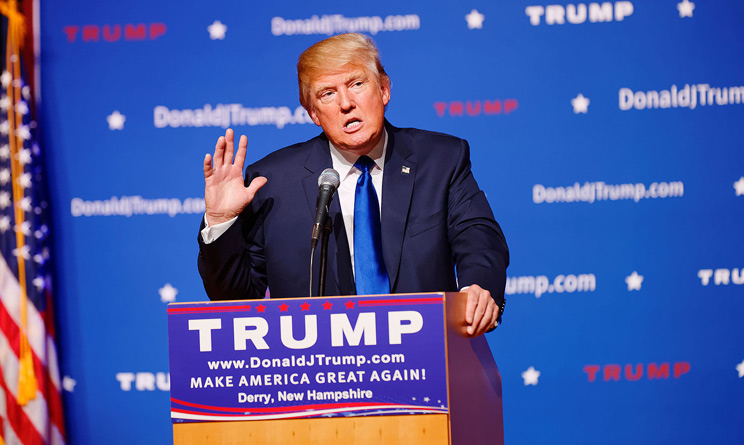Donald Trump’s victories in the primary process make him the frontrunner for the republican nomination. He often brags about his business success, his net worth, along with his negotiating and leadership skills. Clearly Trump’s strategy is trying to that his business experience makes him the most qualified candidate to be president .
Moreover, he uses his business way of thinking to analyze economic problems. Consequently,Trump sees countries as being big corporations that compete against each other . For him the US is a mega-Coca-Cola and China is a mega-Pepsi-Cola.

But nations are not companies: they don’t compete with each other. Countries trade with each other. And the central argument of economics, dating back to Adam Smith, is that voluntary trade is a positive sum game –meaning that those who win do not do it at the costs of others.
So does Trump’s success in the business world give him the requirements needed to be president of the United States? The answer is quite clearly no. The idea that business people know what the economy needs is just wrong.
Economic policy requires a very different kind of thinking from that of appropriate for company strategy
Years ago, Paul Krugman wrote an article titled “A Country is Not a Company.” He argued that economic policy requires a very different kind of thinking from that of company strategy, giving two reasons why this is the case.
- Companies are open systems. They are able to both sell their production to other people and draw in resources from outside. In contrast, countries are mostly closed systems. They mainly sell to themselves and have to make the most of the labor, land and the capital they have.
- Companies are top-down organizations in which people do what they’re told. Market economies are free-for-alls, in which the job of policy is largely to provide incentives to do things.
This second point recognizes the differences between unplanned – spontaneous – orders (such as languages and market economies) and planned organizations (such as business firms and armed forces). Spontaneous orders are the result of human action, but not of human design.
Who Is in Charge of Food Distribution in New York?
The economy, even though many think it has to be consciously directed, is a spontaneous order. Nobody is in charge of food distribution for New York or Barcelona, and yet those cities are still fed every day. There is no overarching central plan or “Big Brother” who guides and coordinates millions of individual choices, actions and plans into the larger outcome of the economy.
How is it then, that coordination is achieved? What is the social institution that coordinates the choices and actions of so many people, each with different slices of knowledge and information? The answer is the market system, that is, thousands of markets where millions of voluntary exchanges take place daily. This spontaneous order is based on the respect to both private property rights and freedom of contract.
Firms are different from markets. Firms are designed and planned organizations. As Ronald Coase explained over 80 years ago, firms exist because going to the market all the time can impose heavy transaction costs. You need to hire workers, negotiate prices and enforce contracts, to name but three time-consuming activities. Firms rely on conscious power, based on long-term contracts, when market-based arrangements are too bothersome.
Many people think the president runs the economy. Consequently, they tend to give too much credit to whichever clever person is standing nearby at the right moment
Managers develop skills based on setting, communicating and implementing strategies that increase firms’ profitability and improve the working environment. These policies are then handed down to employees, who work to accomplish the goals. Good managers are those who can lead and effectively take charge, assign tasks to teams or employees and establish solid deadlines.
These management skills are useful in simple organizations, like firms, but they are not very effective in complex systems like markets. Markets are NOT top-down organizations. The global economy has so many variables that even if a president were to try and take charge of the economy, he simply couldn’t. His policies do have some effect, but he actually runs very little.Nevertheless, many people think the president runs the economy. Consequently, they tend to give too much credit to whichever clever person is standing nearby at the right moment. Individuals, political parties and big companies can make a difference of course. But if there is one dominant misconception about the world, it is that we go around assuming it is much more of a planned place than it is.
There is no doubt that a smart CEO could excel at being president. The risk, though, is that CEOs tend to think they can manage the economy as they do with their companies
I’m not suggesting that business people cannot be outstanding presidents. There is no doubt that a smart CEO could excel at being president. The risk, though, is that CEOs tend to think they can manage the economy as they do with their companies. As Hayek put it: “The curious task of economics is to demonstrate to men how little they really know about what they imagine they can design”.
My aim is to stress that the economic way of thinking is very different from the business way of thinking. MBA students quickly understand that economics courses won’t help them run businesses. The opposite also holds: knowledge on how to run businesses is a futile expertise for economic analysis .



So what about heights? As most it’s statistically shown that most CEO’s are tall. Does this .001% of society share the same height bell curve as the rest of society, or is there a different curve which just happens to have a higher mean height?